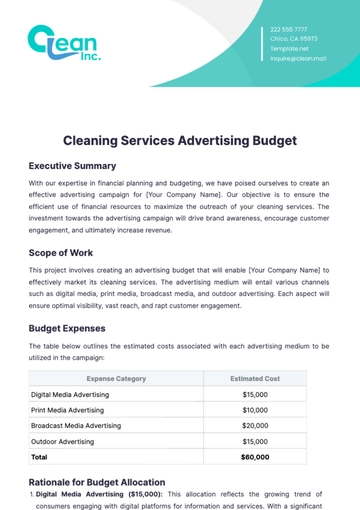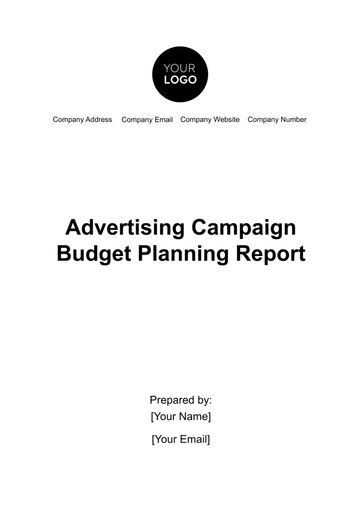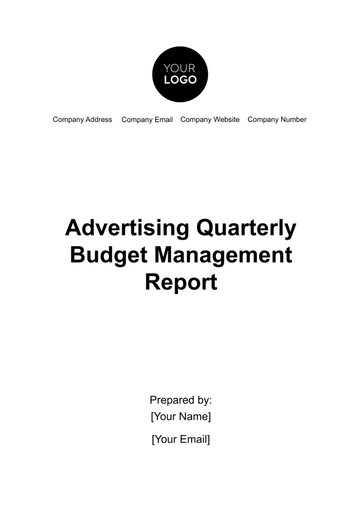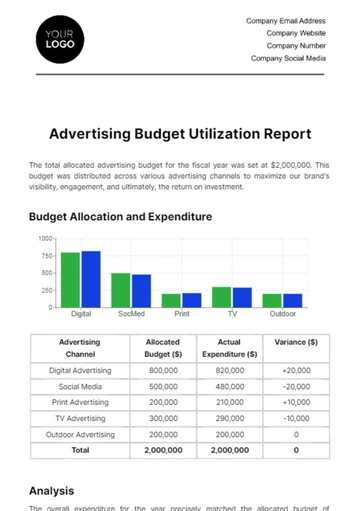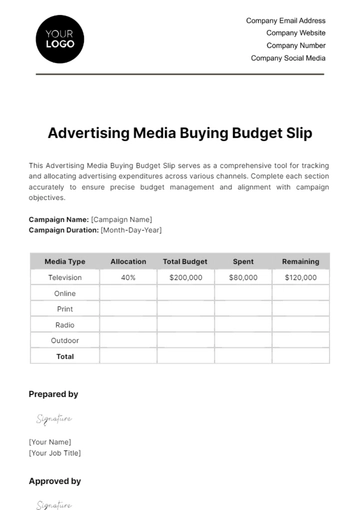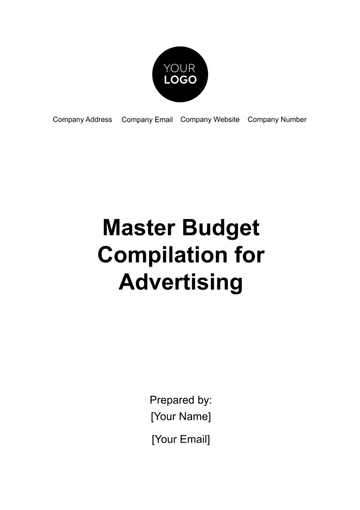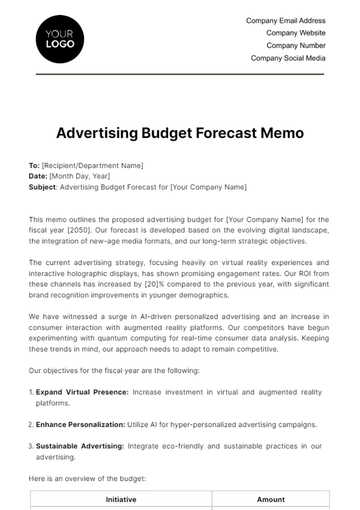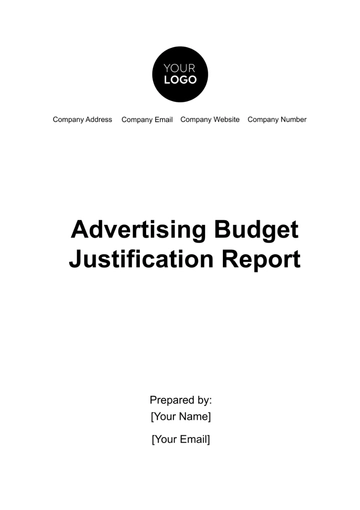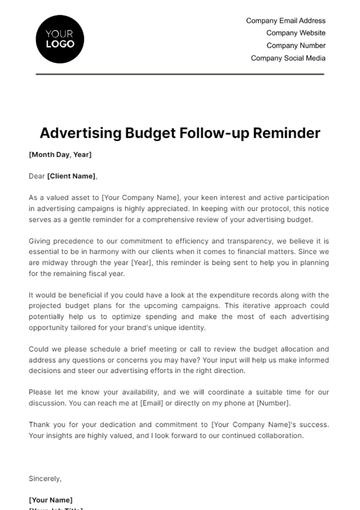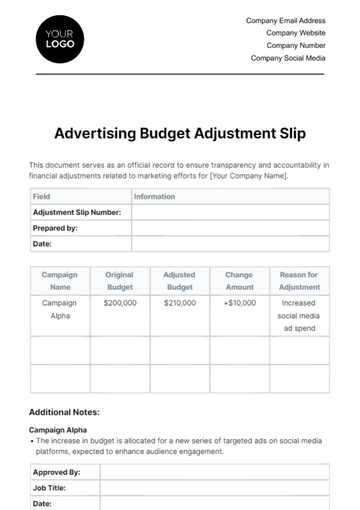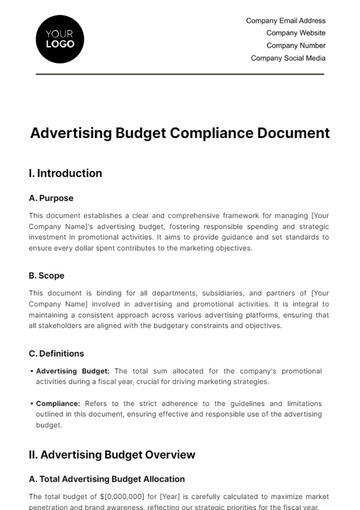Free Advertising Quarterly Budget Management Report

I. Executive Summary
As [Your Company Name] concludes another dynamic quarter in advertising, this executive summary offers a snapshot of our advertising activities and the financial performance associated with these initiatives. The purpose of this summary is to provide a clear and concise overview of our advertising strategies, their execution, and the outcomes, both in terms of engagement and financial returns. By analyzing key highlights and assessing overall budget utilization, we can glean insights into the effectiveness of our advertising efforts and identify areas for future improvement.
A. Brief Overview of the Quarter’s Advertising Activities and Financial Performance
In the past quarter, our total advertising budget was strategically set at $500,000. This budget supported a range of campaigns, including a national digital campaign, a regional TV campaign, and targeted social media promotions. The digital campaign focused on leveraging online platforms to maximize reach and engagement, while the TV campaign aimed at reinforcing brand presence in specific regional markets. The social media promotions were tailored to engage with our target demographic, utilizing platforms where our audience is most active.
B. Key Highlights and Overall Assessment of Budget Utilization
Our digital campaign outperformed expectations, recording a remarkable 40% increase in engagement compared to the previous quarter. This success underscores the effectiveness of our digital strategy and its alignment with current consumer behavior trends. The overall budget utilization was highly effective, with a 95% spend rate, indicating that our budget planning was both realistic and efficient. Notably, ROI improvements were most prominent in our digital channels, which aligns with the global trend of digital advertising offering higher returns compared to traditional media.
II. Budget Overview
The allocation of our advertising budget is a strategic decision that reflects [Your Company Name]'s priorities and market focus for the quarter. This section offers a detailed overview of the total quarterly advertising budget and its distribution across various channels. It underscores our strategic shift towards channels that offer the most significant potential for engagement and ROI and sets the foundation for our advertising strategies.
A. Presentation of Total Quarterly Advertising Budget
For this quarter, we strategically increased our advertising budget by 10% from the previous quarter, totaling an investment of $500,000. This increase is primarily a response to the evolving digital landscape and our objective to capitalize on the opportunities presented by digital advertising platforms. This heightened investment indicates our commitment to staying at the forefront of advertising trends and maximizing our market impact.]
B. Budget Distribution
In line with our strategic focus, the largest portion of our budget - 60% or $300,000 - was allocated to digital advertising. This significant investment reflects the growing importance of digital channels in reaching our target audience effectively. Television advertising received 25% of the budget, amounting to $125,000, underscoring its continued role in building brand awareness and reaching a broader audience. The remaining 15% of the budget, which equates to $75,000, was allocated to print and other media, recognizing the value of a diversified advertising approach.
III. Expenditure Analysis
For [Your Company Name], understanding how our advertising budget is spent across different channels is key to assessing the effectiveness of our marketing strategies. This section delves into a detailed analysis of our expenditures in various advertising channels and examines the variances from our initial budgeting plans. By scrutinizing these aspects, we gain valuable insights into our spending efficiency and can identify opportunities for financial optimization in our advertising efforts.
A. Expenditure by Advertising Channels
Our total expenditure for digital advertising amounted to $290,000, with a significant portion invested in programmatic ads and social media campaigns. This investment reflects our focus on leveraging the precision and efficiency of digital platforms to target our audience effectively. In television advertising, we spent $130,000, primarily focusing on acquiring prime-time slots that offer maximum visibility. Our expenditure in print and other media, which included local newspapers and trade magazines, totaled $80,000, ensuring that we maintain a presence in traditional media channels that are relevant to our target demographic.
B. Variance Analysis
An interesting observation in our expenditure was a 5% underspend in digital advertising. This was primarily due to the efficient use of programmatic ad buying, which allowed for more cost-effective ad placements and better budget utilization. Conversely, we experienced an overspend in television advertising, attributable to last-minute purchases of ad slots at premium rates. This variance highlights the need for more strategic planning in television ad buys to avoid unnecessary premium costs.
IV. Campaign Performance Review
Evaluating the performance of our advertising campaigns is a critical step in understanding the impact of [Your Company Name]'s marketing efforts. This section provides an in-depth analysis of each individual campaign, assessing their reach, engagement, and contribution to our marketing objectives. Additionally, an evaluation of the ROI and overall effectiveness of these campaigns will offer insights into their success and guide future advertising strategies.
A. Individual Campaign Analysis
Our digital campaign achieved substantial reach, garnering 2 million impressions and driving 200,000 visits to our website. These figures indicate the campaign's effectiveness in capturing the attention of our target audience and encouraging engagement with our digital platforms. The television campaign, focusing on the target region, achieved a 15% increase in brand awareness. This improvement in brand awareness underscores the value of television advertising in enhancing our brand's visibility and recall in key markets.
B. ROI and Effectiveness Assessment
The ROI for the digital campaign was impressive, recorded at 3:1. This high return is attributed to the campaign's high conversion rates, reflecting the effectiveness of our targeting and messaging strategies in the digital space. On the other hand, the television campaign yielded a lower ROI of 1.5:1. Despite this, it played a significant role in strengthening our brand positioning, demonstrating the importance of diverse media channels in achieving a well-rounded advertising strategy.
V. Cost Efficiency and Optimization
At [Your Company Name], ensuring that every advertising dollar spent yields maximum value is paramount. This section is dedicated to evaluating the cost efficiency of our advertising channels and exploring strategies for optimizing our budget allocation. The goal is to identify the most financially effective advertising methods and adjust our spending to support the channels that deliver the best results.
A. Cost Efficiency Evaluation
Our analysis of the cost efficiency across various advertising channels revealed that digital advertising stood out in terms of efficiency. The Cost Per Click (CPC) for our digital campaigns was significantly lower than industry averages, indicating that our digital strategy is not only effective in reaching our target audience but also efficient in terms of cost. This efficiency is a result of our targeted advertising approach, which utilizes data analytics and audience segmentation to deliver ads to the most relevant audience, thereby reducing wastage and enhancing ROI.
B. Budget Optimization Strategies
In light of these findings, we suggest a reallocation of funds for the next quarter. Specifically, we recommend reducing the budget allocated to underperforming print ads, which have shown lower engagement and conversion rates, and reallocating these funds to digital mediums. This shift would capitalize on the high efficiency and engagement rates of digital advertising, allowing us to leverage the strengths of online platforms more effectively. This reallocation strategy is in line with current advertising trends, where digital media continues to offer more targeted and measurable advertising opportunities compared to traditional print media.
VI. Market Trends and Competitive Landscape
For [Your Company Name] to remain competitive and effective in its advertising strategies, it's crucial to stay attuned to the ever-evolving market trends and understand the competitive landscape. This section offers a detailed analysis of current trends in the advertising market and examines how our competitors are allocating their advertising budgets. By understanding these dynamics, we can better position our company to capitalize on emerging opportunities and respond to competitive challenges.
A. Market Trend Analysis
One significant trend we've observed is the increasing focus on mobile advertising and video content. With the growing prevalence of smartphones and high-speed internet, consumers are spending more time on mobile devices, making mobile advertising a critical channel for reaching them. Additionally, video content has become increasingly popular due to its ability to engage viewers more effectively than traditional text-based content. Another notable trend is the rise in the use of artificial intelligence (AI) and machine learning for ad targeting and personalization. These technologies enable more precise audience targeting and personalized ad experiences, leading to higher engagement and conversion rates.
B. Competitive Spending Analysis
Our analysis of competitors' spending patterns reveals that there is an average increase of 15% in digital ad spending across the board, indicating a significant market shift toward digital channels. This shift reflects the broader industry trends and the recognition of the effectiveness of digital advertising in reaching and engaging with target audiences. Understanding these spending patterns is crucial for [Your Company Name] as it allows us to benchmark our own spending and strategy against industry standards and competitors' actions.
VII. Future Budget Projections and Recommendations
As [Your Company Name] moves into the upcoming quarter, the importance of strategic budgeting in our advertising operations cannot be overstated. This crucial section of the document not only forecasts the budget for the next quarter but also provides strategic guidance for its allocation. In an ever-evolving market, staying ahead requires not just an alignment with current trends but also an anticipation of future shifts in consumer behavior and technology. Our goal is to strategically position [Your Company Name] in the competitive landscape by maximizing the impact of our advertising investments through foresight and adaptability.
A. Next Quarter’s Budget Forecast
Looking ahead, we have set an advertising budget of $550,000 for the upcoming quarter. This figure represents a calculated increase from our previous quarter's budget, underlining our commitment to seizing the opportunities presented by rapidly evolving digital landscapes and emergent technological innovations.
The rationale for this budget increase is twofold. Firstly, we aim to amplify our presence across various digital channels. These platforms have consistently demonstrated strong returns and high engagement rates, particularly in areas such as targeted advertising and interactive content.
Secondly, a significant portion of this budget is earmarked for investment in burgeoning technologies like augmented reality (AR). AR stands at the forefront of advertising innovation, offering compelling, interactive experiences that can revolutionize the way we connect with our audience. By leveraging AR, we can create immersive brand experiences that not only engage but also leave a lasting impression on consumers.
B. Strategic Budgeting Recommendations
In line with our focus on digital channels, we recommend a 20% increase in the budget allocated to social media and influencer marketing. These platforms have proven to be highly effective in reaching and engaging our target audience, particularly the younger demographics. Additionally, we suggest exploring opportunities in emerging advertising channels such as augmented reality. AR offers unique and immersive experiences that can significantly enhance brand engagement and recall. Investing in such innovative channels can set [Your Company Name] apart from competitors and demonstrate our leadership in adopting cutting-edge advertising technologies.
- 100% Customizable, free editor
- Access 1 Million+ Templates, photo’s & graphics
- Download or share as a template
- Click and replace photos, graphics, text, backgrounds
- Resize, crop, AI write & more
- Access advanced editor
Discover the ultimate solution for seamless advertising budget management with our Advertising Quarterly Budget Management Report Template from Template.net. This editable and customizable template empowers you to effortlessly track expenditures, analyze campaign performance, and optimize strategies. Plus, with our intuitive AI Editor Tool, crafting insightful reports has never been easier. Revolutionize your budgeting process today!
You may also like
- Budget Sheet
- Personal Budget
- Non Profit Budget
- Monthly Budget
- Project Budget
- HR Budget
- Company Budget
- Home Budget
- Weekly Budget
- College Budget
- Business Budget
- Construction Budget
- Small Business Budget
- Hotel Budget
- Annual Budget
- Home Renovation Budget
- Household Budget
- Student Budget
- Grocery Budget
- Marketing Budget
- Corporate Budget
- Startup Budget
- Manufacturing Budget
- Church Budget
- University Budget
- Annual Budget Plan
- Event Budget
- Operating Budget
- Travel Budget
- Food Budget
- IT and Software Budget
- School Budget
- Real Estate Budget
- Sales Budget
- Conference Budget
- Budget Finance
- Freelancer Budget
- Budget Advertising
